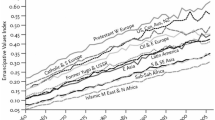Abstract
Measuring genocide is an effort to treat the Holocaust within the framework of the history of ideas, specifically, how an event of enormous magnitude in terms of life and death issues as such embodied within a political system called National Socialism has an intellectual afterlife of some consequence. The article attempts to develop a four-stage post-Holocaust accounting of events that took place between 1933 and 1945. The first stage is biographical and autobiographical, followed by a second stage of ethnographies of survivors and victimizers. The third stage is dominated by historians and social scientific efforts to examine the “logic” of mass murder. The fourth and current stage is microanalysis, in which sharp and clear distinctions are made between differential treatment of victims in a variety of regions, states, nations, and even concentration camps. It should be understood that these four stages do not negate one another but co-exist in the lasting if uneasy effort to understand the Holocaust.
Similar content being viewed by others
References
Ancel Jean (2007) The Economic Destruction of Romanian Jewry. International Institute for Holocaust Research, Yad Vashem, Jerusalem
Aron Raymond (2004) DeGaulle, Israel and the Jews. Transaction, New Brunswick
Biondich Mark (1999) Stjepan Radic, The Croat Peasant Party, and the Politics of Mass Mobilization. University of Toronto Press, Toronto, p 344
Blom, J.C.H., Fuks-Mansfeld, R.G., Schoeffer, I., editors, The History of the Jews in The Netherlands. Oxford: The Littman Library of Jewish Civilization, 2002.
Braham Randolph L. and Chamberlin, Brewster S., editors, The Holocaust in Hungary: Sixty Years Later. New York: Rosenthal Institute for Holocaust Studies, 2006.
Browning Christopher R. (2000) Nazi Policy, Jewish Workers, German Killers. Cambridge University Press, New York
Buckser Andrew (2003) After the Rescue: Jewish Identity and Community in Contemporary Denmark. Macmillan, New York
Dawidowicz, Lucy S., The Holocaust and the Historians. Cambridge: Harvard University Press, 1981.
Dawidowicz Lucy S. (1986) The War against the Jews, 1933–1945. The Free Press, New York
Ehrenburg Ilya, Grossman Vasily (2002) The Complete Black Book of Russian Jewry. Transaction, New Brunswick (translated and edited by David Patterson)
Friedlander Saul (2007) The Years of Extermination: Nazi Germany and the Jews, 1939–1945. Harper Collins, New York
Friedman Tuviah (2006) The Extermination of the Hungarian Jewry and Robbery of Her Property. Institute of Documentation in Israel, Haifa (one volume unpaged)
Goldhagen Daniel Jonah (1996) Hitler’s Willing Executioners: Ordinary Germans and the Holocaust. Knopf/Random House, New York
Hilberg Raul (1971) Documents of Destruction: Germany and Jewry, 1933–1945. Quadrangle Books, Chicago
Hilberg Raul (2003) The Destruction of European Jews (3rd edition)New Haven Yale University Press (in three volumes)
Horowitz Irving Louis (2002) Taking Lives: Genocide and State Power (5th edition). Transaction, New Brunswick
Ioanid Radu (2000) The Holocaust in Romania: The Destruction of Jews and Gypsies under the Antonescu Regime, 1940–1944. Ivan Dee, Chicago (in association with the United States Holocaust Memorial Museum)
Irving David J.C. (1996) Nuremberg: The Last Battle. Focal Point, London
Judt Tony (2005) Postwar: A History of Europe since 1945. Penguin, New York
Kassow Samuel D. (2008) Who Will Write Our History? Emanuel Ringelblum, The Warsaw Ghetto, and the Oyneg Shabes Archive. Indiana University Press, Bloomington
Kiernan Ben (2008) Genocide and Resistance in Southeast Asia: Documentation, Denial and Justice in Cambodia and East Timor. Transaction, New Brunswick
Koestler Arthur (1943) Arrival and Departure. Macmillan, New York
Lipstadt Deborah E. (2005) History on Trial. Ecco Press, New York, p 346
Mahoney Daniel J. (1996) DeGaulle. Statesmanship, Grandeur, and Modern Democracy. Praeger, Westport
McGrath Patrick J. (2008) Arthur Koestler and the ‘Political Libido. Times Literary Supplement 5488:14–15
Mosse George L. (1964) The Crisis of German Ideology: Intellectual Origins of the Third Reich. Grosset & Dunlop, New York
Poliakov, Leon, Wulf, Josef, editors. Das Dritte Reich und die Juden: Dokumente und Aufsaetze. Berlin: Arani, 1955.
Poliakov, Leon, Wulf, Josef, editors. Das Dritte Reich und seine Denker; Dokumente. Berlin: Arani, 1959.
Sarfatti Michele (2006) The Jews in Mussolini’s Italy: From Equality to Persecution. University of Wisconsin Press, Madison
Sevareid Eric (1946) Not So Wild a Dream. Atheneum, New York (1976)
Schwarz-Bart Andre (1960) The Last of the Just. Atheneum, New York
Shirer William L. (1960) The Rise and Fall of the Third Reich: A History of Nazi Germany. Simon & Schuster, New York
Speer Albert (1970) Inside the Third Reich. Weidenfeld and Nicolson, London
Stannard David E. (1977) The Puritan Way of Death: A Study in Religion, Culture, and Social Change. Oxford University Press, New York
Strauss Herbert A. (1981) Jewish Immigrants of the Nazi Period in the United States. Saur, New York (in two volumes)
Rummel R. J. (1992) Democide: Nazi Genocide and Mass Murder. Transaction, New Brunswick
White Theodore H. (1953) Fire in the Ashes: Europe in Mid-Century. Sloane, New York
White Theodore H. (1978) In Search of History: A Personal Adventure. Harper & Row, New York
Zelizer Viviana A. (2005) The Purchase of Intimacy. Princeton University Press, Princeton
Author information
Authors and Affiliations
Corresponding author
Rights and permissions
About this article
Cite this article
Horowitz, I.L. Stages in the Evolution of Holocaust Studies: From the Nuremberg Trials to the Present. Hum Rights Rev 10, 493–504 (2009). https://doi.org/10.1007/s12142-008-0106-y
Published:
Issue Date:
DOI: https://doi.org/10.1007/s12142-008-0106-y




